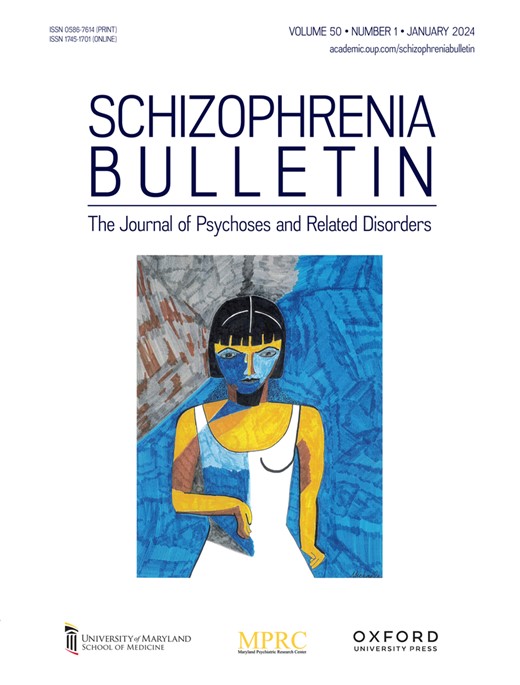Deciphering the Heterogeneity of Schizophrenia: A Multimodal and Multivariate Neuroimaging Framework for Unveiling Brain-Symptom Relationships and Underlying Subtypes
IF 4.8
1区 医学
Q1 PSYCHIATRY
引用次数: 0
Abstract
Background and Hypothesis Schizophrenia manifests large heterogeneities in either symptoms or brain abnormalities. However, the neurobiological basis of symptomatic diversity remains poorly understood. We hypothesized that schizophrenia’s diverse symptoms arise from the interplay of structural and functional alterations across multiple brain regions, rather than isolated abnormalities in a single area. Study Design A total of 495 schizophrenia patients and 507 healthy controls from 8 sites were recruited. Five symptomatic dimensions of schizophrenia patients were derived from the Positive and Negative Syndrome Scale. Multivariate canonical correlation analysis was introduced to identify symptom-related multimodal magnetic resonance imaging composite indicators (MRICIs) derived from gray matter volume, functional connectivity strength, and white matter fractional anisotropy. The intergroup differences in MRICIs were compared, and the paired-wise correlations between symptom dimensions and MRICIs were resolved. Finally, K-means clustering was used to identify the underlying biological subtypes of schizophrenia based on MRICIs. Study Results Canonical correlation analysis identified 15 MRICIs in schizophrenia that were specifically contributed by the neuroimaging measures of multiple regions, respectively. These MRICIs can effectively characterize the complexity of symptoms, showing correlations within and across symptom dimensions, and were consistent across both first-episode and chronic patients. Additionally, some of these indicators could moderately differentiate schizophrenia patients from healthy controls. K-means clustering identified 2 schizophrenia subtypes with distinct MRICI profiles and symptom severity. Conclusions Symptom-guided multimodal and multivariate MRICIs could decode the symptom heterogeneity of schizophrenia patients and might be considered as potential biomarkers for schizophrenia.解读精神分裂症的异质性:揭示脑症状关系和潜在亚型的多模态和多变量神经影像学框架
背景与假设精神分裂症在症状或大脑异常方面表现出很大的异质性。然而,症状多样性的神经生物学基础仍然知之甚少。我们假设精神分裂症的各种症状是由多个大脑区域的结构和功能改变的相互作用引起的,而不是单个区域的孤立异常。研究设计共从8个地点招募了495名精神分裂症患者和507名健康对照者。精神分裂症患者的5个症状维度由阳性和阴性证候量表得出。引入多元典型相关分析,从灰质体积、功能连接强度和白质分数各向异性中识别与症状相关的多模态磁共振成像复合指标(MRICIs)。比较mri组间差异,解决症状维度与mri之间的成对相关性。最后,采用K-means聚类方法基于mri识别精神分裂症的潜在生物学亚型。典型相关分析确定了精神分裂症患者的15个mri,这些mri分别是由多个区域的神经成像测量所具体贡献的。这些mri可以有效地表征症状的复杂性,显示症状维度内部和跨症状维度的相关性,并且在首发和慢性患者中都是一致的。此外,其中一些指标可以适度区分精神分裂症患者与健康对照。K-means聚类鉴定出两种精神分裂症亚型具有不同的MRICI谱和症状严重程度。结论症状引导的多模态和多变量mri可以解码精神分裂症患者的症状异质性,可能被认为是精神分裂症的潜在生物标志物。
本文章由计算机程序翻译,如有差异,请以英文原文为准。
求助全文
约1分钟内获得全文
求助全文
来源期刊

Schizophrenia Bulletin
医学-精神病学
CiteScore
11.40
自引率
6.10%
发文量
163
审稿时长
4-8 weeks
期刊介绍:
Schizophrenia Bulletin seeks to review recent developments and empirically based hypotheses regarding the etiology and treatment of schizophrenia. We view the field as broad and deep, and will publish new knowledge ranging from the molecular basis to social and cultural factors. We will give new emphasis to translational reports which simultaneously highlight basic neurobiological mechanisms and clinical manifestations. Some of the Bulletin content is invited as special features or manuscripts organized as a theme by special guest editors. Most pages of the Bulletin are devoted to unsolicited manuscripts of high quality that report original data or where we can provide a special venue for a major study or workshop report. Supplement issues are sometimes provided for manuscripts reporting from a recent conference.
 求助内容:
求助内容: 应助结果提醒方式:
应助结果提醒方式:


